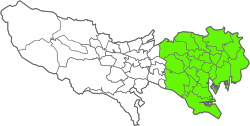23 wards
|
Special wards of Tokyo 東京特別区 |
|
|---|---|
 Located in the green highlights |
|
 |
|
| Country | Japan |
| Island | Honshu |
| Region | Kantō |
| Prefecture | Tokyo |
| Area | |
| • 23 special wards | 619 km2 (239 sq mi) |
| Population (October 1, 2016) | |
| • 23 special wards | 9,375,104 |
| • Density | 15,146/km2 (39,230/sq mi) |
The special wards (特別区 tokubetsu-ku) are 23 municipalities that together make up the core and the most populous part of Tokyo, Japan. Together, they occupy the land that was originally Tokyo City before it was abolished in 1943 to become part of the newly created Tokyo Metropolis. The special wards' structure was established under the Japanese Local Autonomy Law and is unique to Tokyo. Nevertheless, analogues exist in historic and contemporary Chinese and Korean administration.
In Japanese, they are commonly known as the 23 wards (23区 nijūsan-ku). Confusingly, all wards refer to themselves as a city in English, but the Japanese designation of special ward (tokubetsu ku) remains unchanged. Moreover, in everyday English, Tokyo as a whole is also referred to as a city. Thus, the closest English equivalents for the special wards would be the London boroughs or New York City boroughs, and this can help to understand their structures and functions. However, Greater London and New York City only consist of boroughs (plus the City of London), whereas Tokyo contains 62 municipalities of which only 23 are special wards.
This is merely a grouping of special wards; there is no associated single government body of wards separate from the Tokyo Metropolitan Government which governs all of Tokyo, not only the special wards.
Although special wards are autonomous from the Tokyo metropolitan government, they also function as a single urban entity in respect to certain public services, including water supply, sewage disposal, and fire services. These services are handled by the Tokyo metropolitan government, whereas cities would normally provide these services themselves. This situation is identical between the Federal District and its 31 administrative regions in Brazil. To finance the joint public services it provides to the 23 wards, the metropolitan government levies some of the taxes that would normally be levied by city governments, and also makes transfer payments to wards that cannot finance their own local administration.
...
Wikipedia
